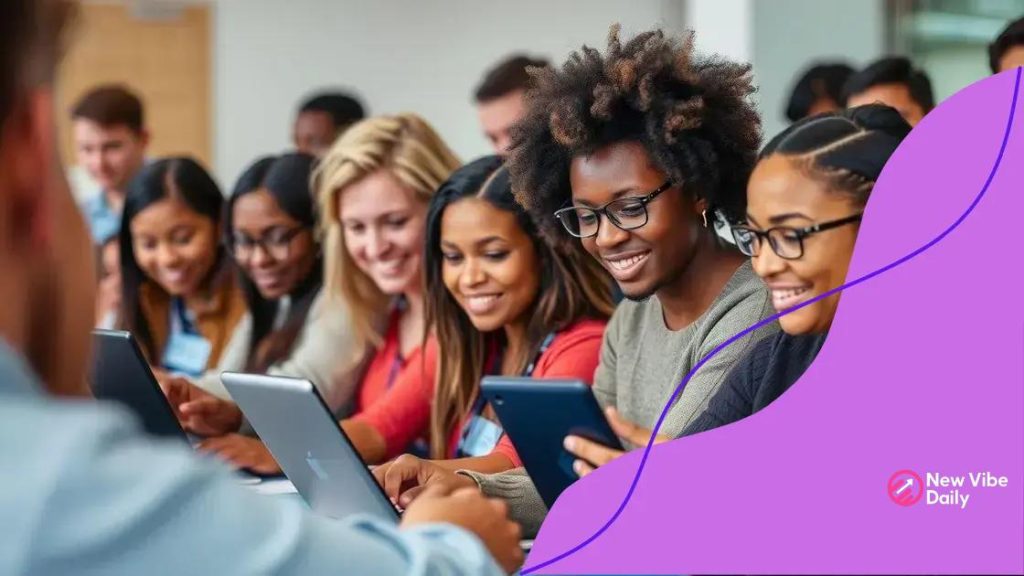Addressing issues of digital equity and access effectively

Addressing issues of digital equity and access involves understanding barriers such as financial limitations and lack of digital literacy, while also implementing successful initiatives to promote inclusion for all communities.
Addressing issues of digital equity and access is essential in ensuring everyone benefits from the digital age. Have you ever wondered how access to technology shapes our opportunities? In this article, we’ll delve into the challenges and solutions surrounding this critical issue.
Understanding digital equity and its importance
Understanding digital equity is crucial to ensure that everyone has equal access to technology and the internet. This topic affects how people engage in society, learn, and work. In today’s world, where digital tools are essential, recognizing its importance can lead to significant changes.
Digital equity means that everyone can access the same resources, regardless of their background. It involves not just access to devices, but also to the skills and support needed to use them effectively. By focusing on digital equity, we can help bridge the gaps that exist in education, employment, and health services.
The Importance of Digital Equity
Without digital equity, many individuals face obstacles that prevent success. These challenges can lead to greater disparities in society. To grasp the importance of this concept, consider the following:
- Access to quality education for all.
- Enhanced job opportunities in a tech-driven market.
- Improved healthcare access and communication.
- Greater participation in civic engagement and community activities.
When society values digital equity, it recognizes that technology can empower all individuals. For example, students in underserved areas can achieve more with the right tools and training. This empowerment is vital for creating a well-informed and productive community.
Moreover, businesses benefit from a more equitable workforce. Increased access means more diverse ideas and solutions, encouraging innovation. Companies that promote digital equity can attract a wider talent pool, ultimately leading to growth.
Challenges to Digital Equity
Despite its significance, there are many hurdles we face. Devices may be available, but without proper training and support, many people still remain at a disadvantage. It’s also important to address the perception that technology is not for everyone. Changing these mindsets plays a key role in achieving digital equity.
Efforts to improve digital equity must engage stakeholders, from community leaders to educators and policymakers. Collaborative initiatives are essential for making lasting impact. By working together, we can ensure that everyone benefits from the digital age, paving the way for a brighter future for all.
Barriers to access in today’s society
Barriers to access in today’s society are significant challenges that hinder many individuals from experiencing digital equity. These obstacles can prevent people from fully participating in the digital world. Understanding these barriers is essential for promoting growth and equality.
Many factors contribute to the lack of access. For instance, financial limitations can restrict people from acquiring devices or internet services. Additionally, some may live in areas where reliable internet is not available, making it difficult to connect.
Types of Barriers
Recognizing the specific types of barriers helps to address them effectively. Here are some major barriers:
- Economic barriers: High costs of technology and internet services.
- Geographical barriers: Limited infrastructure in rural and underserved areas.
- Educational barriers: Lack of digital literacy training and support.
- Cultural barriers: Perceptions and attitudes towards technology use.
Each of these barriers plays a role in maintaining differential access to digital resources. For example, individuals from low-income families may struggle to afford laptops or smartphones. Similarly, people living in rural regions may have difficulty accessing broadband connections. When technology is out of reach, it deepens existing inequalities in society.
Education also plays a vital role in addressing these challenges. Many people simply do not know how to use technology, which can lead to a feeling of exclusion. Educational programs that focus on building digital skills can aid in overcoming these challenges. In doing so, individuals feel empowered and capable of engaging in the digital landscape.
The Need for Solutions
Addressing these barriers requires a collective effort from society. Governments, organizations, and communities must work together to create solutions. Initiatives can include providing affordable technology, enhancing infrastructure, and promoting educational opportunities focused on technology. By recognizing and addressing barriers, we can move towards a more inclusive digital future.
Real-world impacts of digital inequity

The real-world impacts of digital inequity manifest in many areas of life, touching education, employment, and health. When people lack access to technology, they experience a range of disadvantages that can lead to long-term consequences. Understanding these impacts is vital for fostering change.
In education, students without reliable internet or devices often fall behind their peers. This gap in access can result in lower grades and limited opportunities for higher education. For instance, students in rural areas may struggle to participate in online learning, leaving them at a disadvantage.
Employment Issues
Similarly, digital inequity affects job prospects. Many employers require digital skills for even entry-level positions. Without access to technology, individuals may miss opportunities for training and job applications. They can feel excluded from the workforce, leading to economic challenges.
- Limited access to job training programs.
- Difficulty in submitting online applications.
- Lack of networking opportunities due to technology barriers.
- Decreased employability because of missing digital skills.
Furthermore, health care is also impacted by digital inequity. Access to telehealth services has increased, especially during recent times. However, those without the necessary technology or internet may struggle to receive care. This situation can worsen health outcomes, particularly for vulnerable populations.
In daily life, the effects of digital inequity are often felt in community engagement as well. Individuals without access may miss out on important information and resources. They may not be able to participate in local decisions or initiatives that affect their lives. This exclusion can lead to feelings of disenfranchisement.
Broader Social Implications
The broader social implications of digital inequity contribute to societal divides. Lack of access perpetuates inequalities that affect generations. Communities that invest in closing the digital divide not only enhance individual lives but also strengthen the fabric of society. By addressing these impacts, we pave the way for a more inclusive future.
Strategies to promote digital inclusion
Promoting digital inclusion requires a thoughtful approach. Various strategies can be employed to ensure everyone has access to technology and the internet. These methods address barriers and encourage equitable opportunities for all.
One effective strategy is to establish community programs aimed at providing access to technology. These programs can offer resources like free Wi-Fi, computers, and digital literacy training. Local libraries and community centers can play a crucial role in this effort.
Enhancing Digital Literacy
Digital literacy is essential for individuals to benefit from technology. Programs that teach basic computer skills can empower people to use the internet effectively. Offering workshops tailored to different age groups helps everyone become comfortable with technology.
- Basic computer skills training for all ages.
- Workshops on safe internet practices.
- Courses on job search skills using online resources.
- Programs that teach coding and advanced tech skills.
Another vital strategy is partnering with local businesses and organizations. These collaborations can create pathways for job opportunities that emphasize the importance of digital skills. By working together, businesses can offer training programs that prepare individuals for the workforce.
Additionally, advocacy for policy changes is crucial. Supporting initiatives that aim to expand broadband access can help bridge the digital divide. Governments and local agencies must prioritize investments in infrastructure to ensure that rural and underserved communities have the connectivity they need.
Community Engagement
Engaging the community in discussions about digital inclusion can bring awareness to the issue. Organizing forums and outreach events can highlight the importance of technology access. Local leaders and residents can share their experiences and brainstorm solutions together.
In conclusion, implementing these strategies not only promotes digital inclusion but also fosters a more equitable society. Everyone deserves the opportunity to benefit from the digital world, and working towards these goals can create lasting change in communities.
Case studies of successful initiatives
Case studies of successful initiatives offer valuable insights into how communities can tackle digital equity challenges. By examining these examples, we can learn effective strategies that can be replicated elsewhere.
One notable initiative is the ConnectHomeUSA program, which provides internet access to low-income families living in public housing. This initiative connects children to online resources, enabling better educational opportunities. Communities involved in this program have seen improved academic performance among students.
Another Example: The Digital Inclusion Fund
The Digital Inclusion Fund operates in various cities, aiming to enhance digital literacy among residents. This fund supports local organizations that offer training and resources. The program has resulted in thousands of participants gaining essential tech skills, bridging the gap between those who have access and those who do not.
- Funding for training programs in underserved areas.
- Providing devices to low-income families.
- Partnership with schools to integrate digital learning.
- Community workshops to promote digital skills.
In another example, the EveryoneOn initiative focuses on connecting people in need with affordable internet services. This program has connected millions to low-cost internet plans, empowering them to participate fully in the digital age. By making access affordable, many families now have opportunities for online education and job searching.
Highlighting such successful initiatives demonstrates the potential for positive change. Each case illustrates how targeted efforts can lead to meaningful improvements in digital access and literacy. These programs not only benefit individuals but also strengthen the community as a whole.
Key Takeaways from Success Stories
Analyzing successful initiatives allows stakeholders to understand what works. Key common elements include community involvement, strong partnerships, and tailored resources. Focusing on these aspects can enhance future efforts to promote digital inclusion.
In conclusion, addressing digital equity and access is vital for creating a fair and inclusive society. Understanding the barriers to access helps us develop effective strategies, such as community programs and partnerships. By learning from successful initiatives, we can further promote digital inclusion. Together, we can ensure everyone has the opportunity to thrive in the digital world!
FAQ – Questions About Digital Equity and Access
What is digital equity?
Digital equity means ensuring everyone has equal access to technology and the internet, regardless of their background or location.
What are some barriers to digital access?
Barriers include financial limitations, lack of infrastructure in rural areas, educational gaps in digital literacy, and cultural attitudes towards technology.
How can communities promote digital inclusion?
Communities can promote digital inclusion through programs that provide free internet access, digital literacy training, and partnerships with local organizations.
What are some examples of successful initiatives for digital equity?
Programs like ConnectHomeUSA and EveryoneOn have been effective in providing internet access and digital skills training to underserved populations.






